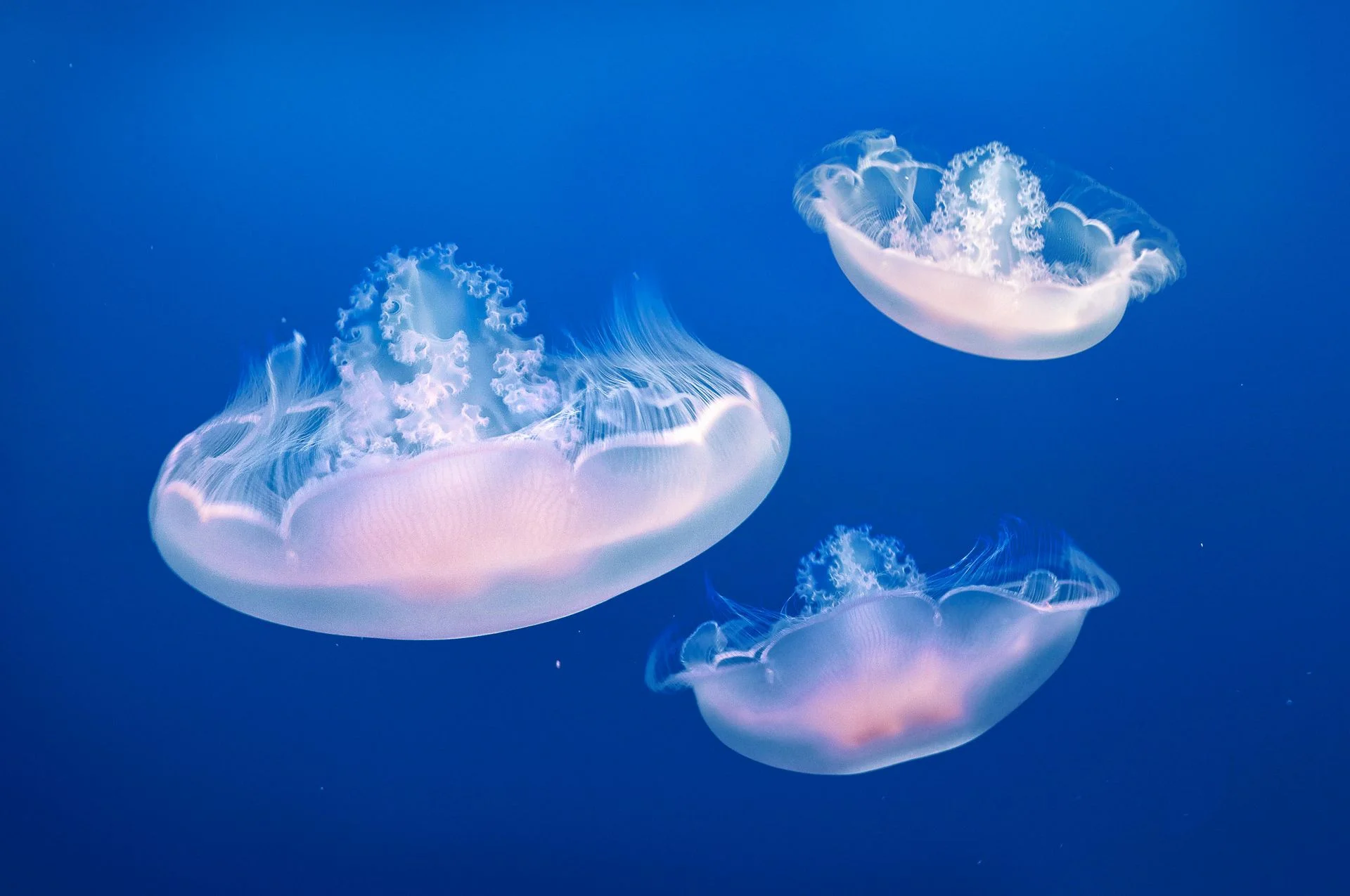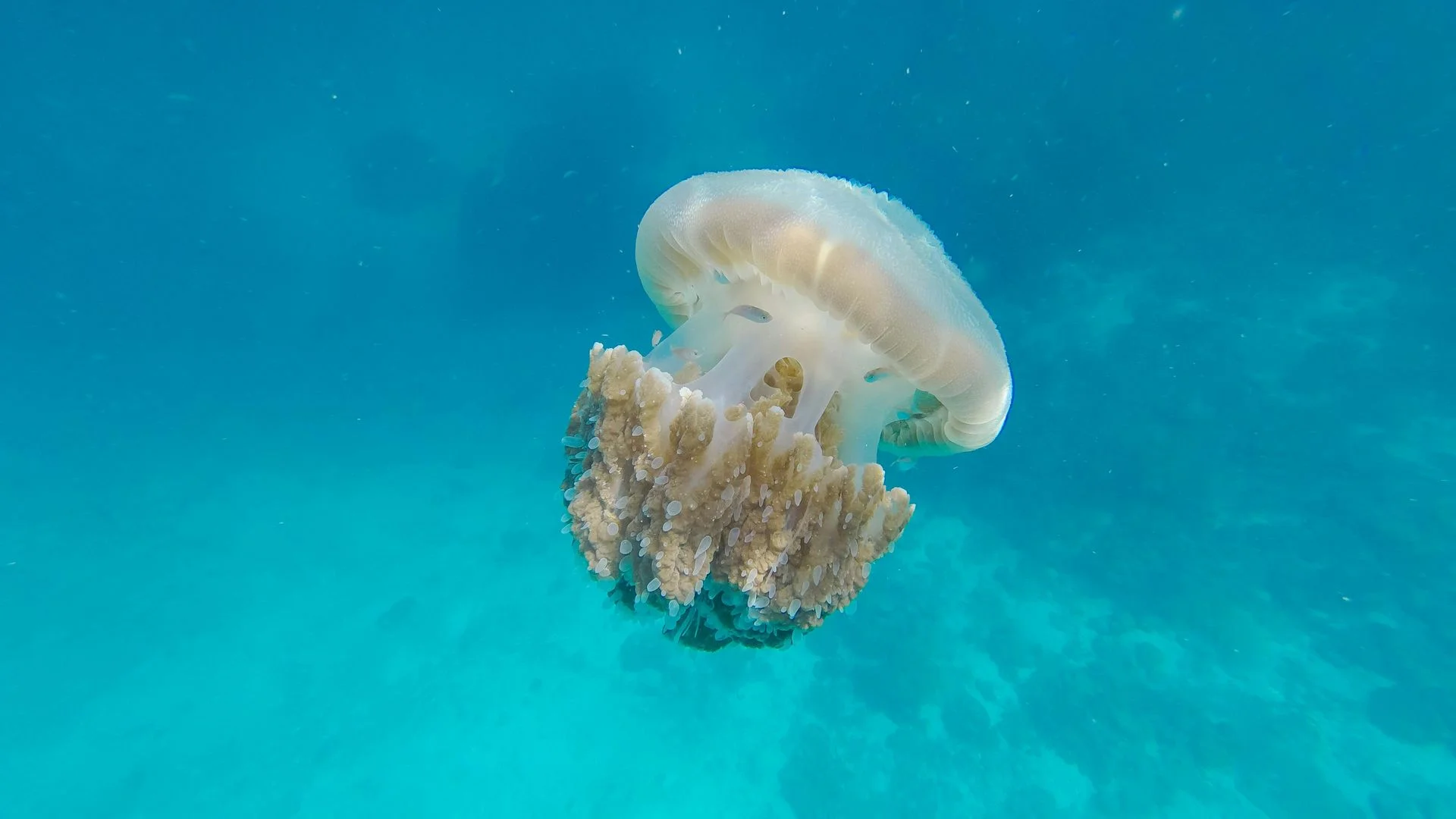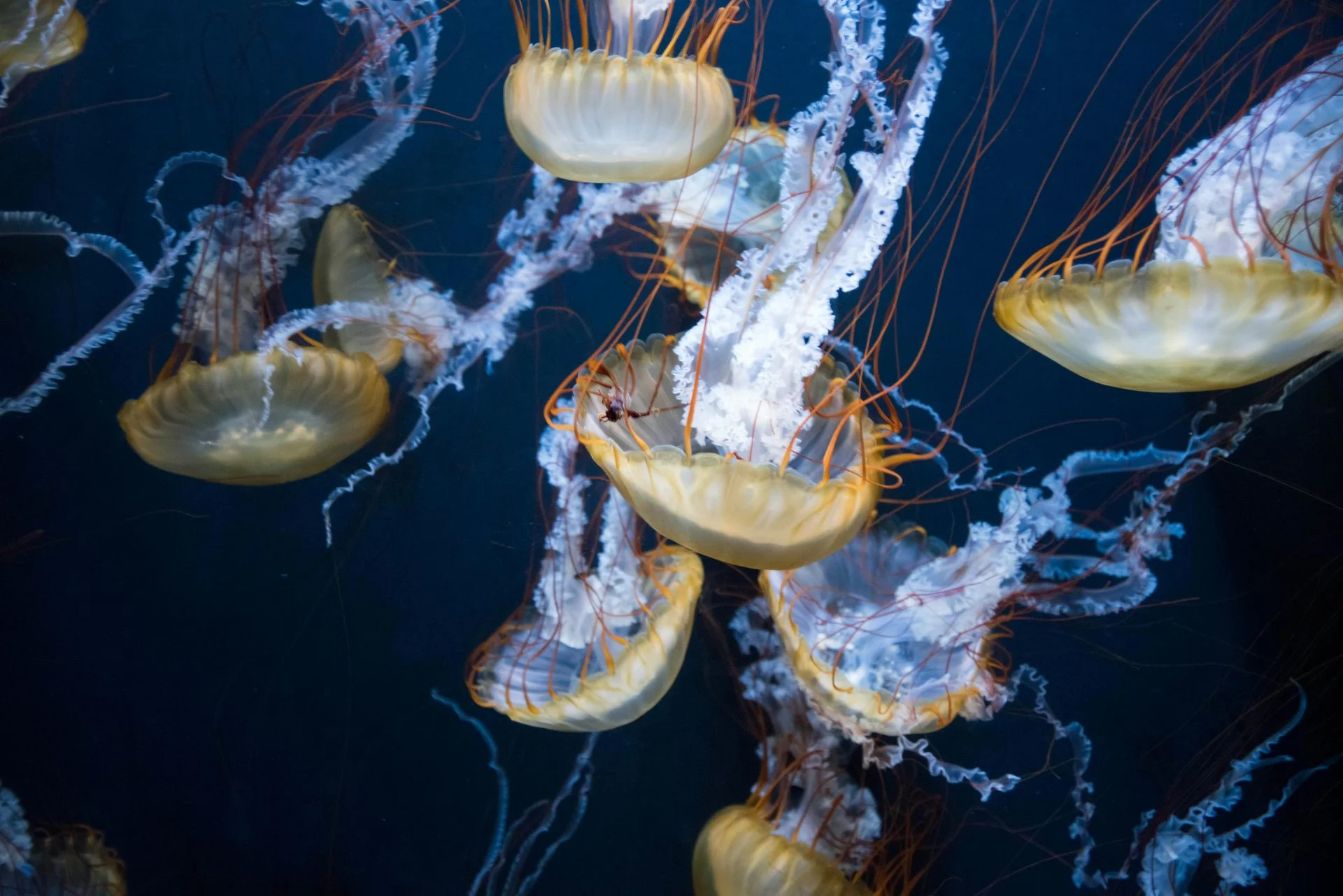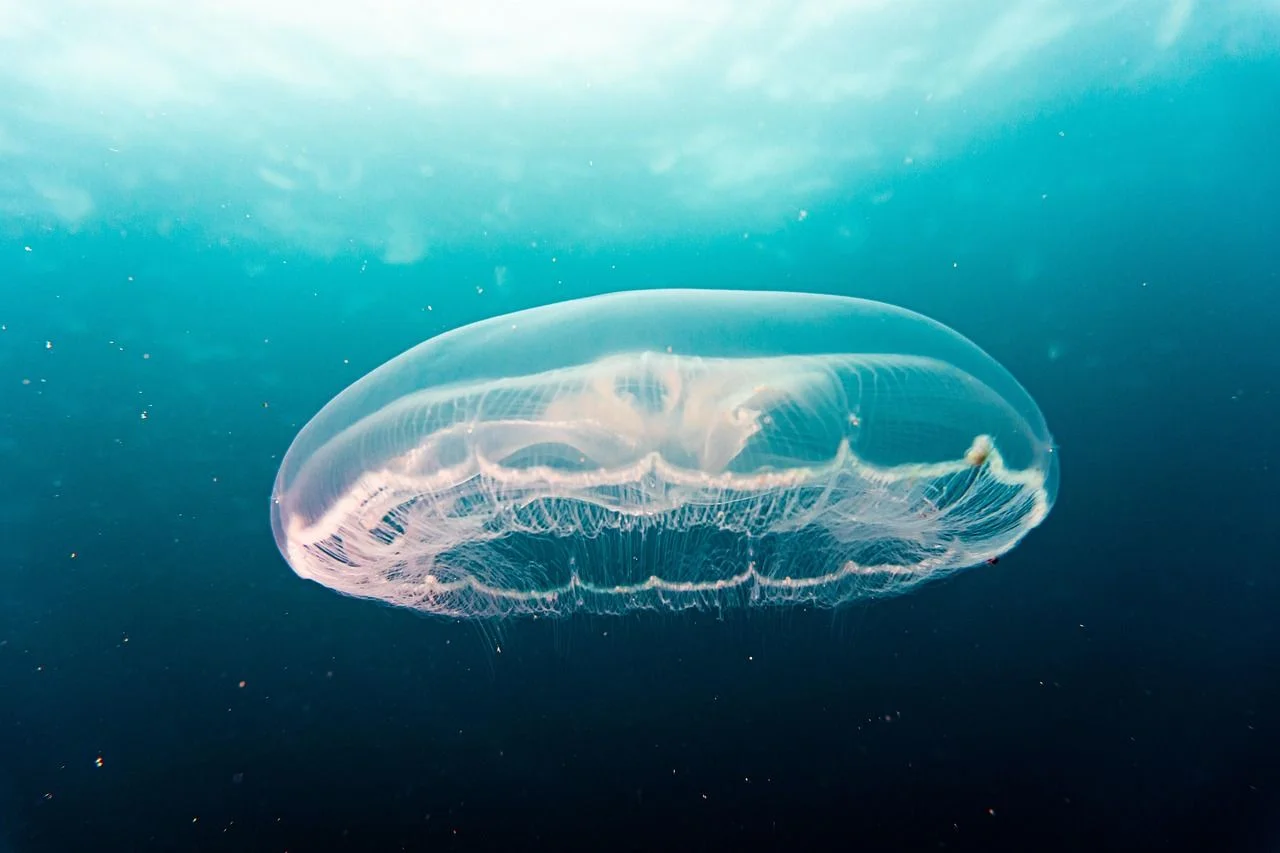Jellyfish
Scyphozoa

Jellyfish are fascinating marine invertebrates belonging to the sub-phylum Medusozoa of the phylum Cnidaria. Despite their common name, they are not fish—they lack backbones, fins, and the typical anatomy of fishes.
🔬Classification
📏Physical Features
🌊Habitat Info
⚠️Safety & Conservation
Identification Guide

Jellyfish exhibit a wide variety of colors and patterns, ranging from transparent or milky white to vibrant pink, blue, purple, and golden hues. Some species, like the Moon Jellyfish (Aurelia aurita), have a nearly transparent bell with faint radial lines and a four-leaf-clover pattern visible in the center — these are its gonads. Others, such as the Lion’s Mane Jellyfish (Cyanea capillata), display reddish or orange tones and possess a spectacular array of long, hair-like tentacles.
Their tentacles can differ greatly in shape and function: some are long and fine, drifting elegantly with currents, while others are thicker and shorter, arranged in clusters around the bell’s edge. Jellyfish do not have eyes in the human sense, but many species have light-sensitive organs (ocelli) along the bell margin, allowing them to sense brightness and orientation.
The body contour is typically circular and symmetrical, with the bell’s gentle pulsation giving them their signature drifting motion. Depending on the species, the bell can be smooth, ribbed, or even fringed.
Differences from Similar Species
Jellyfish are often mistaken for comb jellies (Ctenophores). However, comb jellies lack stinging cells and instead use rows of cilia plates to move, which refract rainbow colors when light passes through. Jellyfish, by contrast, move by contracting their bell and have stingers capable of paralyzing prey.
Juvenile vs. Adult
One common diving photography misunderstanding is that juvenile jellyfish may look completely different from adults. Many start life as tiny polyps attached to rocks or shells, later transforming through a process called strobilation into free-swimming ephyrae (miniature jellyfish). Juveniles often have fewer tentacles and simpler bells, which can lead divers to think they are a different species altogether.
Top 10 Fun Facts about Jellyfish

1. They Can Live Forever — Kind Of
The species Turritopsis dohrnii, known as the “immortal jellyfish,” can revert its adult cells back into a juvenile stage after reaching maturity, essentially restarting its life cycle and avoiding natural death (unless eaten or diseased).
2. Glowing in the Dark
Many jellyfish are bioluminescent, producing their own light using special proteins like GFP (Green Fluorescent Protein) — a discovery that later revolutionized molecular biology research and even earned a Nobel Prize.
3. No Brain, No Heart, No Problem
Jellyfish lack a brain, heart, and bones, yet they function perfectly well using a nerve net that helps coordinate movement and responses to stimuli.
4. They’re Ancient Survivors
Fossil evidence shows jellyfish existed before dinosaurs, more than 500 million years ago, thriving through all five mass extinctions that wiped out countless other species.
5. A Shocking Defense System
Their stinging cells, or nematocysts, can fire microscopic harpoons loaded with venom in less than a microsecond, one of the fastest actions in nature.
6. Some Don’t Even Need to Swim
Jellyfish are mostly drifters, relying on ocean currents for movement. Some can travel long distances without actively swimming — nature’s perfect minimalist travelers.
7. Delicate Yet Dangerous
The box jellyfish, found mainly in Australian waters, has venom so powerful it can stop a human heart in under two minutes.
8. Part of the Ocean’s Food Chain and Garbage Disposal
Jellyfish eat plankton, small fish, and even other jellyfish, while also being prey for sea turtles, sunfish, and seabirds — keeping the ocean’s food web in balance.
9. They’re in Our Myths and Art
In many cultures, jellyfish symbolize grace, immortality, and mystery. Japanese folklore, for instance, depicts them as divine messengers of the sea.
10. Scientists Still Discover New Species Every Year
Deep-sea exploration continues to reveal previously unknown jellyfish species, including some that resemble floating fireworks or glass sculptures — reminders of how much of the ocean remains unexplored.
Diving & Observation Notes

🧭 Best Observation Approach
When diving with jellyfish, the best way to observe them is to approach slowly and from the front or slightly below, rather than from behind or above. Jellyfish are extremely sensitive to water movement, and sudden currents caused by fins can push them away or damage their delicate tentacles. Maintain neutral buoyancy and stay still when close — let the current carry both you and the jellyfish naturally.
📸 Photography Tips
- Lighting: Use soft lighting or side illumination to enhance the jellyfish’s translucence and glowing patterns. Avoid strong direct strobe flashes, which can cause backscatter in plankton-rich waters.
- Angles: The most aesthetic shots are often slightly upward angles, showing the bell’s curvature and trailing tentacles against the blue background.
- Macro or Wide? For small species (like comb jelly types), use macro or close-focus wide-angle; for large species (like Lion’s Mane Jellyfish), a wide-angle lens gives a sense of scale and flow.
- Movement Shots: Slow shutter speeds (1/30–1/60) with gentle panning can capture their drifting motion beautifully.
⚠️ Safety & Behavior
- Most jellyfish are non-aggressive, but some species are venomous, particularly box jellyfish and sea nettles.
- Maintain a safe distance (at least 1–2 meters) unless the local guide confirms it’s harmless.
- Avoid touching or brushing past tentacles — even detached ones can still sting.
- If stung, rinse with vinegar, not freshwater, to neutralize nematocysts, and seek medical help if pain persists.
🌏 Local Dive Guide Insights
- In Raja Ampat (West Papua), jellyfish blooms can sometimes be seen in calm lagoons or sheltered bays, especially around Gam Island and Misool.
- The Derawan Islands (East Kalimantan) are home to the famous Kakaban Jellyfish Lake, where you can safely swim among non-stinging jellyfish — one of the few such places in the world.
- In Bali's Tulamben or Nusa Penida, small moon jellies are often seen drifting near the surface during night dives under the beam of your torchlight.
Best Places to Dive with Jellyfish

Palau
Rising out of the western Pacific at the meeting point of two great oceans, Palau is an archipelago of more than 500 jungle‑cloaked islands and limestone rock pinnacles. Its barrier reef and scattered outcrops create caverns, walls, tunnels and channels where nutrient‑rich currents sweep in from the Philippine Sea. These flows feed carpets of hard and soft corals and attract vast schools of jacks, barracudas and snappers, as well as an impressive cast of pelagics. Grey reef and whitetip sharks parade along the legendary Blue Corner; manta rays glide back and forth through German Channel’s cleaning stations; and Ulong Channel offers a thrill‑ride drift over giant clams and lettuce corals. Between dives you can snorkel among non‑stinging jellyfish in Jellyfish Lake or explore WWII ship and plane wrecks covered in colourful sponges.

Raja Ampat
Raja Ampat, the “Four Kings,” is an archipelago of more than 1,500 islands at the edge of Indonesian West Papua. Its reefs sit in the heart of the Coral Triangle, where Pacific currents funnel nutrients into shallow seas and feed the world’s richest marine biodiversity. Diving here means gliding over colourful walls and coral gardens buzzing with more than 550 species of hard and soft corals and an estimated 1,500 fish species. You’ll meet blacktip and whitetip reef sharks on almost every dive, witness giant trevally and dogtooth tuna hunting schools of fusiliers, and encounter wobbegong “carpet” sharks, turtles, manta rays and dolphins. From cape pinnacles swarming with life to calm bays rich in macro critters, Raja Ampat offers endless variety. Above water, karst limestone islands and emerald lagoons provide spectacular scenery between dives.

Maratua(Derawan)
Maratua Atoll, part of the remote Derawan Archipelago off East Kalimantan, offers thrilling big‑fish dives and rich reefs fed by nutrient‑charged currents. From swirling barracuda tornadoes and reef sharks at the world‑famous Big Fish Country to turtle cleaning stations and macro‑rich jetties, the island’s more than 20 sites deliver everything from ripping drift dives to gentle coral gardens. Expect encounters with green and hawksbill turtles, schooling snapper and jackfish, manta and eagle rays, nurse and reef sharks and even occasional hammerheads. The underwater topography is just as varied—vertical walls, coral pinnacles, sand channels and lush lagoon reefs mean you can pack your logbook with completely different experiences each day. Because Maratua sits far from major tourist hubs, you’ll often have the reef to yourself.